If ![]() and
and ![]() are vectors, the dot product of
are vectors, the dot product of ![]() and
and ![]() is defined algebraically as
is defined algebraically as
![]()
Example. (a) Compute the dot product ![]() .
.
(b) Compute the dot product ![]() .
.
(a)
![]()
(b)
![]()
The dot product of two vectors is a number. Since numbers are often referred to as scalars, the dot product is often called the scalar product.
The definition works just as well for vectors with 2 components, or more than 3 components. For example, here is the dot product of two 4-dimensional vectors:
![]()
Here are some properties of the dot product.
Theorem. Let ![]() and let
and let ![]() .
.
(a) ![]()
(b) ![]()
(c) ![]()
(d) ![]()
Proof. All of these results can be proved by writing the vectors in terms of components and computing.
As an example, I'll prove (d) for 3-dimensional vectors. Suppose ![]() . Then
. Then
![]()
The dot product also has a geometric interpretation.
Theorem. Let ![]() and
and ![]() be vectors and let
be vectors and let ![]() be the angle
between them. Then
be the angle
between them. Then
![]()
Note: Since ![]() , it does not matter
whether
, it does not matter
whether ![]() is measured counterclockwise or clockwise.
is measured counterclockwise or clockwise.
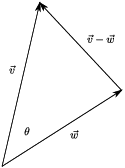
Proof. Apply the Law of Cosines and use the
fact that ![]() :
:
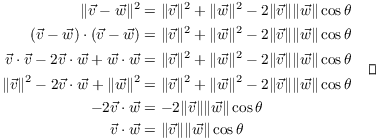
You can often use vectors to obtain results by computing things algebraically, then interpreting the results geometrically. In this case, you can do this because there are two ways of looking at the dot product.
For example, when will two vectors be perpendicular? This will happen
if the angle between them is ![]() . In either case,
. In either case, ![]() , and
hence
, and
hence ![]() .
.
Going the other way, if ![]() and
and ![]() are nonzero
vectors and
are nonzero
vectors and ![]() , then
, then ![]() . Therefore,
. Therefore, ![]() , so
, so ![]() and the vectors
are perpendicular.
and the vectors
are perpendicular.
Notes. 1. The word " orthogonal" is synonymous with "perpendicular".
2. The zero vector ![]() is trivially perpendicular to any
other vector. But usually you want a nonzero vector
perpendicular to another vector, and I'll try to be careful to ask
for a nonzero vector.
is trivially perpendicular to any
other vector. But usually you want a nonzero vector
perpendicular to another vector, and I'll try to be careful to ask
for a nonzero vector.
In addition:
(a) If ![]() , the angle between the vectors is acute.
, the angle between the vectors is acute.
(b) If ![]() , the angle between the vectors is obtuse.
, the angle between the vectors is obtuse.
Note that you can prove these geometric facts about two vectors even though it might be hard to determine them by drawing the vectors. And while we'll be primarily concerned with vectors in 2 and 3 dimensions, these facts about angles and dot products are true in n dimensions.
Example. Determine whether the vectors make an acute angle, an obtuse angle, or are perpendicular.
(a) ![]() ,
, ![]() .
.
(b) ![]() ,
, ![]()
(a)
![]()
Since ![]() ,
, ![]() , and the
angle between the vectors is obtuse.
, and the
angle between the vectors is obtuse.![]()
![]()
The vectors are perpendicular.![]()
Example. Find the exact value of the cosine of
the angle between ![]() and
and ![]() .
.
Tell whether the vectors are orthogonal; if not, tell whether the angle between them is acute or obtuse.
![]()
The angle is obtuse.![]()
Example. Find two unit vectors which
are perpendicular to ![]() . How many unit vectors are
perpendicular to
. How many unit vectors are
perpendicular to ![]() ?
?
![]() is perpendicular to
is perpendicular to ![]() , since the two
vectors have dot product 0 by inspection.
, since the two
vectors have dot product 0 by inspection. ![]() , so the vectors
, so the vectors ![]() and
and ![]() are
unit vectors perpendicular to
are
unit vectors perpendicular to ![]() .
.
There are infinitely many unit vectors perpendicular to ![]() .
.
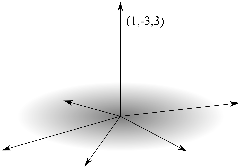
If ![]() is like a flagpole, think of vectors pointing along
the ground away from the base of the flagpole. Each may be divided by
its length to get a unit vector.
is like a flagpole, think of vectors pointing along
the ground away from the base of the flagpole. Each may be divided by
its length to get a unit vector.
Algebraically, they are the unit vectors ![]() such that
such that ![]() .
.![]()
Example. Find a nonzero vector which is
simultaneously orthogonal to both ![]() and
and ![]() .
.
Let ![]() be such a vector. I want
be such a vector. I want
![]()
This gives the equations
![]()
Since I have two equations but three variables, I can't expect a unique solution.
I'll eliminate one of the variables to start with. The first equation gives
![]()
Substitute this into ![]() to get
to get
![]()
At this point, I can assign a value of my choice to one of the
variables. Let ![]() . Then
. Then ![]() , so
, so ![]() . Plugging these values into
. Plugging these values into ![]() , I get
, I get ![]() .
.
Thus, ![]() is perpendicular to
is perpendicular to ![]() and
and ![]() . In fact, any solution must be a
multiple of the vector I found, since the vectors perpendicular to
both
. In fact, any solution must be a
multiple of the vector I found, since the vectors perpendicular to
both ![]() and
and ![]() form a line.
form a line.
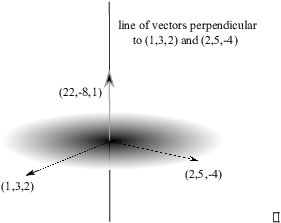
Example. Find vectors ![]() ,
, ![]() , and
, and ![]() such that
such that
![]()
There are lots of possibilities. For instance,
![]()
But ![]() .
.![]()
The scalar component of ![]() in the direction of
in the direction of ![]() is
is
![]()
It gives the (signed) length of the "shadow" that ![]() makes on
makes on ![]() . It is positive if
. It is positive if ![]() and
and ![]() point in the same direction (i.e.
if the angle between them is acute) and negative if
point in the same direction (i.e.
if the angle between them is acute) and negative if ![]() and
and ![]() point in the opposite direction
(i.e. if the angle between them is obtuse).
point in the opposite direction
(i.e. if the angle between them is obtuse).

To see this, consider the right triangle in the picture. The base of
the triangle is ![]() ,
and
,
and
![]()
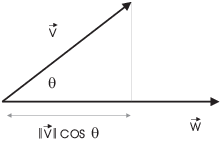
But
![]()
Therefore,
![]()
Example. If ![]() and
and
![]() , find the scalar component of
, find the scalar component of ![]() in the direction of
in the direction of ![]() .
.
![]()
The vector projection of ![]() in the direction of
in the direction of ![]() is vector whose
(signed) length is
is vector whose
(signed) length is ![]() and whose direction is the direction of
and whose direction is the direction of ![]() .
.
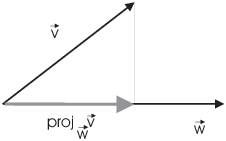
To obtain it, I multiply ![]() by
the unit vector
by
the unit vector ![]() which has the same direction as
which has the same direction as ![]() . This gives
. This gives
![]()
Thus, the formula is
![]()
Example. Find the vector projection of ![]() in the direction of
in the direction of ![]() .
.
![]()
Copyright 2017 by Bruce Ikenaga